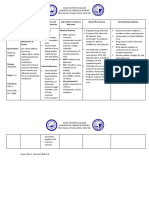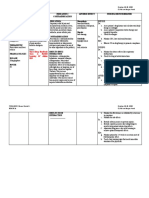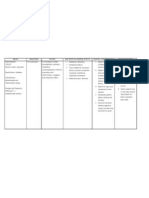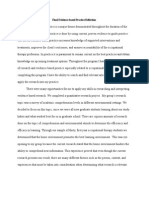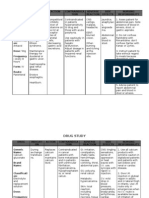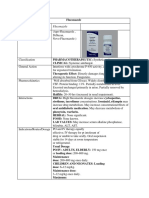Drug Study Cefuroxime
Drug Study Cefuroxime
Uploaded by
Dave Michael GeliCopyright:
Available Formats
Drug Study Cefuroxime
Drug Study Cefuroxime
Uploaded by
Dave Michael GeliOriginal Description:
Copyright
Available Formats
Share this document
Did you find this document useful?
Is this content inappropriate?
Copyright:
Available Formats
Drug Study Cefuroxime
Drug Study Cefuroxime
Uploaded by
Dave Michael GeliCopyright:
Available Formats
Name of Drug Generic Name: Cefuroxime DRUG STUDY Trade Name: Ceftin Content: Classification of Drug Therapeutic: Anti-infectives
Mechanism of Action Bind to bacterial cell wall membrane, causing cell death Indication Treatment of It is effective for the treatment of penicillinaseproduc ingNeisseria gonorrhoea(PPNG). Effectively treats bone and joint infections, bro nchitis, meningitis, gonorrhea, otitis media, pharyngitis/tonsilliti s, sinusiti s, lower respiratory tract infections, skin and soft tissue infections, urinary tract infections, and is used for surgical prophylaxis, reducing or eliminating infection. Contraindications Hypersensitivity to cephalosporins and related antibiotics; pr egnancy (category B), lactation. Side Effects GI: Diarrhea, nausea, antibioticassociated colitis. Skin: Ra sh , p ruritus, urticaria. Urogenital: Increased serum creatinine and BUN, decreased cr eatinine clearance. Hemat: Hemolytic anemia MISC: Anaphylaxis Nursing Responsibilities Before: Determine history Pharmacologic: Second Therapeutic Effects: generation Bactericidal action Cephal osporins Pregnancy Catergory B of hypersensitivity reacti ons to cephalosporins, penicillins, and history of al lergies, particularly to drugs, before therapy is initiated. Maximum Dose: Minimum Dose: Availability: Tablets: 125mg, 250mg, 500mg Powder fo r injection: 750mg, 1.5g, 7.5g Premixed containers: 750 mg/50ml, 1.5g/50ml Sourc e: Davis Drug Guide for Nurses 10th Edition Lab tests: Perform culture and sensitivity tests before initiation of therapy and periodically duri ng therapy if indicated. Therapy may be instituted pending test results. Monitor periodically BUN and creatinine clearance. During: Inspect IM and IV injection sites frequently for signs of phlebitis. Monitor for manifestations of hypersensitivity (see
You might also like
- In Summary of Discharge TeachingDocument2 pagesIn Summary of Discharge Teachingdalaginding clophNo ratings yet
- Brand Name: Dilantin Generic Name: Phenytoin Indication: Dilantin Is IndicatedDocument4 pagesBrand Name: Dilantin Generic Name: Phenytoin Indication: Dilantin Is Indicatedianecunar100% (1)
- Drug Study CefuroximeDocument2 pagesDrug Study CefuroximeTipey Segismundo100% (1)
- Drug Study Cefazolin and Vit KDocument2 pagesDrug Study Cefazolin and Vit KFrancis Lawrence AlexanderNo ratings yet
- DrugStudy - CamaristaColeenMaeC (BSN III-G) (Prednisone)Document2 pagesDrugStudy - CamaristaColeenMaeC (BSN III-G) (Prednisone)Coleen Mae CamaristaNo ratings yet
- Co AmoxiclavDocument3 pagesCo AmoxiclavNikki Bontia CarvajalNo ratings yet
- OB Drug StudyDocument12 pagesOB Drug StudyCj AttoNo ratings yet
- Generic Name: Acute Aspirin ToxicityDocument1 pageGeneric Name: Acute Aspirin ToxicityShermayne Mallapre HernandezNo ratings yet
- Oral Suspension: 125 mg/5 Powder For Injection: 750 Premixed Containers: 750Document1 pageOral Suspension: 125 mg/5 Powder For Injection: 750 Premixed Containers: 750Diane Grace PadillaNo ratings yet
- Name of Drug Classification of Drug Mechanism of Action Indication Contraindications Side Effects Nursing ResponsibilitiesDocument4 pagesName of Drug Classification of Drug Mechanism of Action Indication Contraindications Side Effects Nursing ResponsibilitiesNemo Del RosarioNo ratings yet
- (Brand Name) & Date Ordered General Class and Family Specific IndicationDocument2 pages(Brand Name) & Date Ordered General Class and Family Specific IndicationNicole Grace VillegasNo ratings yet
- CELLULITIS NCPDocument7 pagesCELLULITIS NCPGwayne Gumangi UnsingNo ratings yet
- Brand Name: Dalacin C Generic Name: Clindamycin HCL Drug ClassificationDocument2 pagesBrand Name: Dalacin C Generic Name: Clindamycin HCL Drug Classificationianecunar100% (1)
- Drug Study Cap RHPDocument7 pagesDrug Study Cap RHPJan DeeNo ratings yet
- CephalexinDocument3 pagesCephalexinCiera YoungNo ratings yet
- CefadroxilDocument2 pagesCefadroxilArvie AlvarezNo ratings yet
- Drug CarbocisteineDocument1 pageDrug CarbocisteineDhan LopezNo ratings yet
- Drug StudyDocument14 pagesDrug StudyNikki RodrigoNo ratings yet
- ProgesteroneDocument1 pageProgesteroneAGUIRANG, Crystal Joyce R.No ratings yet
- Vit K Drug Study PDFDocument2 pagesVit K Drug Study PDFA sisonNo ratings yet
- Piperacillin Tazobactam (Zosynpiperacillin)Document1 pagePiperacillin Tazobactam (Zosynpiperacillin)ENo ratings yet
- Drug Study For Cefazolin Drug Data Classificat Ion Mechani SM of Action Indicatio Ns Contraindica Tions Adverse Effect Nursing Responsibil ItiesDocument2 pagesDrug Study For Cefazolin Drug Data Classificat Ion Mechani SM of Action Indicatio Ns Contraindica Tions Adverse Effect Nursing Responsibil ItiesCarl J.No ratings yet
- 4 Cefazolin Drug StudyDocument4 pages4 Cefazolin Drug Studyshadow gonzalezNo ratings yet
- Nurse'Sdrug Handbook Jones & Bartlett Learning 14 Edition 2015Document2 pagesNurse'Sdrug Handbook Jones & Bartlett Learning 14 Edition 2015Bianca Nicole Gacad FernandezNo ratings yet
- AzithromycinDocument1 pageAzithromycincoleenlimkinNo ratings yet
- Drug Study AzithromycinDocument2 pagesDrug Study Azithromycinkuro hanabusaNo ratings yet
- Drug Study Vitamin C + ZincDocument2 pagesDrug Study Vitamin C + ZincKrizzia FosterNo ratings yet
- Celecoxib CelebrexDocument1 pageCelecoxib CelebrexBeverly Ann de LeonNo ratings yet
- Jacildo LT Module 6 TCNDocument2 pagesJacildo LT Module 6 TCNMeryville JacildoNo ratings yet
- Paracetamol (Alvedon) Acetylcysteine Fluimucil KCL (Kalium Durule)Document1 pageParacetamol (Alvedon) Acetylcysteine Fluimucil KCL (Kalium Durule)Jesse James Advincula EdjecNo ratings yet
- TRAMADOLDocument4 pagesTRAMADOLRudie Lee PascualNo ratings yet
- Actos Drug StudyDocument2 pagesActos Drug StudyNathalie kate petallarNo ratings yet
- Physical Exam - AppendectomyDocument8 pagesPhysical Exam - Appendectomyirish felixNo ratings yet
- Ceftaroline Teflaro CefotaximeDocument3 pagesCeftaroline Teflaro CefotaximeKristi WrayNo ratings yet
- CefepimeDocument3 pagesCefepimeMae Ann Bueno CastillonNo ratings yet
- AzithromycinDocument1 pageAzithromycinGrape JuiceNo ratings yet
- DRUG STUDY OmeprazoleDocument3 pagesDRUG STUDY OmeprazoleBRYCE WILLIAM GONo ratings yet
- Drug StudyDocument4 pagesDrug StudyHennah ReblandoNo ratings yet
- Drug Study HepatitisDocument7 pagesDrug Study HepatitisKateLayaogNo ratings yet
- DioxelDocument1 pageDioxelJosselle Sempio CalientaNo ratings yet
- AMARYL 1mg, 2mg, 3mg, 4mg: 1 Indications and UsageDocument16 pagesAMARYL 1mg, 2mg, 3mg, 4mg: 1 Indications and Usageddandan_2No ratings yet
- Drug StudyDocument5 pagesDrug Studyjanelle123 toribioNo ratings yet
- Ranitidine, ParacetamolDocument3 pagesRanitidine, ParacetamoltaekadoNo ratings yet
- Timolol MaleateDocument3 pagesTimolol MaleateAP TOROBXNo ratings yet
- Final Eb ReflectionDocument2 pagesFinal Eb Reflectionapi-238460511No ratings yet
- Nifedipine and Prednisone Drug StudyDocument5 pagesNifedipine and Prednisone Drug StudyAllyne GavinoNo ratings yet
- Drug StudyDocument3 pagesDrug StudyMarychen Cabunas100% (1)
- Sodium BicarbonateDocument1 pageSodium BicarbonateALbinong VelascoNo ratings yet
- CelecoxibDocument2 pagesCelecoxibHazelSteffiNo ratings yet
- Drug StudyDocument2 pagesDrug StudyAlesandra MocorroNo ratings yet
- CELECOXIBDocument2 pagesCELECOXIBElaine Iris AbastaNo ratings yet
- FluconazoleDocument3 pagesFluconazoleMary Kate ClarosNo ratings yet
- Insulin As PartDocument3 pagesInsulin As PartRezaNo ratings yet
- Drug Study - CefazolinDocument5 pagesDrug Study - CefazolinNichole DancelNo ratings yet
- Drug-Study HydrocortisoneDocument4 pagesDrug-Study HydrocortisoneChristian Neil PonceNo ratings yet
- Paracetamol - Drug StudyDocument1 pageParacetamol - Drug StudyPatricia Reese YutiamcoNo ratings yet
- The Ride of Your Life: What I Learned about God, Love, and Adventure by Teaching My Son to Ride a BikeFrom EverandThe Ride of Your Life: What I Learned about God, Love, and Adventure by Teaching My Son to Ride a BikeRating: 4.5 out of 5 stars4.5/5 (2)
- DS CefuroximeDocument1 pageDS CefuroximeTetma VillasorNo ratings yet
- Drug Study CefuroximeDocument1 pageDrug Study CefuroximeKarmell Maliwanag100% (2)
- Drug Study CeftriaxoneDocument2 pagesDrug Study CeftriaxoneJuko FernandezNo ratings yet
- Introduction To ManagementDocument22 pagesIntroduction To ManagementDave Michael GeliNo ratings yet
- Generations of Computer: Mary Joshua L. Indac Aapd2BDocument4 pagesGenerations of Computer: Mary Joshua L. Indac Aapd2BDave Michael GeliNo ratings yet
- Case Study - Finals NCP 1&2Document4 pagesCase Study - Finals NCP 1&2Dave Michael GeliNo ratings yet
- Case ScenarioDocument40 pagesCase ScenarioDave Michael GeliNo ratings yet
- Chronic Obstructive Pulmonary Disease (Copd)Document11 pagesChronic Obstructive Pulmonary Disease (Copd)Dave Michael GeliNo ratings yet




